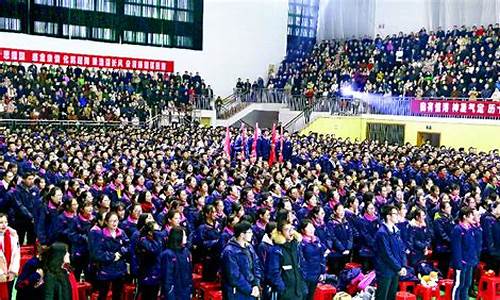高考语法动词-高考动词考点
1.高考英语语法:表示“变化”连系动词
2.高考英语语法辅导:非谓语动词做定语
3.高考英语语法:高中英语语法-非谓语动词1
4.高考英语语法:高中英语语法-动词不定式用法举要
高考英语语法:表示“变化”连系动词

高考英语语法:表示“变化”连系动词的用法
英语中表示“变化”的连系动词主要有 become, come, go, get, grow, turn等。使用时注意以下几点:
一、become 和get的用法
主要指一个人暂时性的身心变化或永久性的自然变化。如:
Hearing this, the boss became [got] angry. 听到这事,老板就生气。
The travelers became [got] thirsty. 旅客们渴了。
Soon the man became famous. 不久后这个人就出名了。
If you eat such food you’ll get [become] fat. 如果你吃那样的食物,你会发胖的。
另外,还有become [get] ill, old, well, deaf, strong, etc (得病,变老,痊愈,变聋,变强,等)。
另外,become 和 get 还可用于指天气的变化和社会的趋势。如:
It’s becoming [getting] cold (dark, cloudy). 天渐冷了(黑了,多云了)。
Divorce is becoming [getting] more common. 离婚现象越来越常见了。
This design of resident buildings is becoming [getting] fashionable. 这种住宅楼的设计正在逐渐流行起来。
二、go 和come 的用法
两者均可表示变化,但前者主要指一种由强到弱或由好到坏的变化(可用于人或事物),后者则主要指向好的方面变化。如:
go bald (deaf, insane, etc) 发秃,变聋,发疯,等
The meat’s gone off [gone bad]. 肉变味(变坏)了。
The radio’s gone wrong. 收音机出毛病了。
Her wish came true. 她的愿望实现了。
Everything came right. 一切顺利。
另外,go还可用于人或事物颜色的变色,与turn用法相同。如:
She went [turned] blue with cold. 她冻得脸色发青了。
The rotten meat went [turned] green. 这块腐烂的肉变绿了。
说明:
1. go 一般不与 old, tired, ill 等连用,遇此情况要用其他连系动词。如:
grow [get] old 变老 fall [become] ill 生病
fall [become] sick 生病 get [feel] tired 疲劳
2. go后接形容词通常表示结果(见上例),但在个别搭配中也可表示状态。如:
go hungry 挨饿 go naked 光着身子
3. come 除表示向好的方面变化外,还有以下常见搭配值得注意。如:
come untied 解开 come loose 变松 come undone 松开
三、grow 的用法
grow 主要表示逐渐变化,强调变化的过程。如:
It began to grow dark. 天色渐渐黑了。
Bob is growing old. 鲍勃渐渐变老了。
The sea is growing calm. 大海变得平静起来。
The pollution problem is growing serious. 污染问题日趋严峻。
四、关于结构
以上提到的连系动词通常接形容词作表语,但有的还可接其他结构,如come, get, grow后可接不定式,become, turn后可接名词,go, get, grow后可接介词短语。如:
You’ll soon grow to like her. 你很快就会喜欢她的。
Soon I came to like him. 不久我便开始喜欢他了。
It’s becoming a serious problem.它正在成为一个严重问题。
The little plant grew into a tree. 幼苗长成了一棵树。
They went out of fashion years ago.它们好多年前已变得不时新了。
说明:turn后接名词时,往往表示意想不到的变化,名词前通常用零冠词。如:
He turned writer after he graduated from a medical college. 他从医学院毕业后当了作家。(比较:He became a writer after graduating from college.)
高考英语语法辅导:非谓语动词做定语
南开中学 李士明
非谓语动词做定语
直接修饰名词的成分称为定语,一般由形容词或名词担当,也可以分别由不定式、分词或动名词等非谓语动词来担当。那么如何区别并正确使用非谓语动词呢?
NON-FINITES
1. 现在分词与过去分词的区别
我们知道非谓语动词都源于及物和不及物两种谓语动词,要了解现在分词与过去分词的区别就要从谓语动词的基本属性开始。
1)及物动词 (v.t.)
及物动词的主语我们称为动作的发出者(sender),宾语称为动作的承受者(receiver)。
例如:
The news surprised
动词+ing (发出者) 及物动词v.t.
the students.
动词+ed (承受者)
Surprise是及物动词, 在使用surprise这个动词的非谓语分词形式时,修饰动作发出者news用现在分词形式(动词+ing),修饰动作的承受者用过去分词形式(动词+ed)。
●They are talking about the surprising news. (surprising做定语修饰发出者news)
The news is surprising. (surprising做表语修饰发出者news)
They are talking about the surprised students. (surprised做定语修饰承受者students)
The students are surprised. (surprised做表语修饰承受者students)
再来看几个例子:
●exciting games激烈精彩的比赛, excited spectators激情振奋的观众
●disappointing results令人沮丧的结果, disappointed people大失所望的人们
●exhausting work令人疲惫不堪的工作, exhausted workers筋疲力尽的工人
●moving stories感人肺腑的故事, moved students感激涕零的学生
从以上例子可见,现在分词和过去分词都可以用作形容词来修饰名词,修饰动作发出者用现在分词,修饰动作承受者用过去分词。要特别注意的是,依据被修饰的名词是人还是物来判断现在分词和过去分词的用法是不准确的。
例如: They complicated the situation by introducing some more restriction.
他们采用了一些更多的限制把形势复杂化了。
及物动词complicate的发出者是人they, 而承受者是物。因此,“复杂恶化的形势”应译为the complicated situation,“形势是令人棘手的” 应译为The situation is complicated.
从这个例子可以清楚地看出,如果根据中文,很容易将“令人棘手的形势”错误地理解为 “complicating situation”。
再比如我们常用的:
a broken cup 一个破杯子; spoken English英语口语;exported products出口产品。
因此,准确了解所修饰的名词与及物动词的关系,是正确使用及物动词的现在分词和过去分词的关键。
2) 不及物动词(v.i.)
不及物动词只有动作的发出者,不存在动作的承受者。因此,不及物动词的现在分词源于进行时,表示动作正在进行,而过去分词则源于完成时,表示动作已完成。
例如:
●He looked at the leaves which are falling in the air.(从句用进行时修饰名词the leaves)
他看着空气中飘然下落的叶子。
=He looked at the leaves falling in the air.(现在分词短语修饰名词the leaves表示进行)
=He looked at the falling leaves in the air. (现在分词修饰名词the leaves表示进行)
●He walked on the leaves which had fallen on the ground.(从句用完成时修饰名词the leaves) 他走在地面的落叶上。
He walked on the leaves fallen on the ground.(过去分词短语修饰名词leaves表示过去)
He walked on the fallen leaves on the ground. (过去分词修饰名词leaves表示过去)
●the rising sun. = the sun that is rising. 冉冉升起的太阳
the risen sun = the sun that has risen. 已经升在天空的太阳
●boiling water = water which is boiling. 沸腾的水
boiled water = water which has boiled 开过的水
2. 不同形式不定式做定语的区别
动词不定式的一般式可以用做形容词,担当名词的定语, 表示将要发生的动作,不定式的进行式和完成式都不可以用作定语。
1)及物动词不定式一般式主动to do sth和被动to be done 两种形式的区别。
例如:
●Have you anything to send? = Have you anything that you will send?
你有什么东西要(自己)寄吗?(主动含义,动作由you自己去完成)
(to send做定语, 源于定语从句that you will send, 修饰先行词anything, 表示将来。)
●Have you anything to be sent (by others)?=Have you anything that will be sent(by others)?
你有什么东西要(我或别人)寄吗?(被动含义,动作由他人others去完成)
(to be sent做定语, 源于定语从句that will be sent, 修饰先行词anything, 表示将来。)
从以上两个例子可以看出,不定式的主动形式to send来源于主动语态的定语从句。
而不定式的被动形式to be sent来源于被动语态的定语从句, 不能错误地认为to send 是主动形式表示被动,准确地讲应该牢记主动形式的不定式源于主动语态的从句,被动形式的不定式则源于被动语态的从句,两者绝不可以混淆。
●I have some books for you to read. = I have some books that you should read.
我有几本书希望你读一读。
(for you to read做定语, 源于定语从句that you should read, 修饰先行词books, 表示将来。原从句的主语you在不定式的前面以for you 的形式出现,担当不定式的逻辑主语。)
2)不及物动词不定式一般式做定语
当不及物动词做定语时, 后面必须有相应的介词与前面所修饰的名词相呼应, 从汉语角度理解,而忽略了必要的介词是不及物动词做定语时常见的错误。
例如:
●He is looking for a room to live in.= He is looking for a room which he will live in.
他现在正在找房间住。
(to live in做定语, 源于定语从句which he will live in, 修饰先行词room, 表示将来。)
●Would you like to have another pen to write with? ( to write with the pen)
你需要再准备一支笔用吗?
●Smith is a good man to work with. ( to work with the man)
与史密斯一起工作是再好不过了。
●Lei Feng is a brilliant example for us to learn from. ( to learn from the example)
雷锋是我们学习的光辉榜样。
●Can you lend me a chair to sit on?
您可以借给我一把椅子坐吗?
●Global Financial Crisis is a hot topic to talk about today. ( to talk about the topic)
全球性金融危机是当前人们谈论的热点话题。
高考英语语法:高中英语语法-非谓语动词1
《高中英语语法-非谓语动词1》由出国留学我精心为您学习英语准备.liuxue86.com。本内容整理时间为05月12日,如有任何问题请联系我们。
非谓语动词1
动词不定式、分词(现在分词,过去分词)和动名词统称为非谓语动词。现代英语将现在分词和动名词合为一大类叫作v + ing形式。这些动词的形式不能在句中单独作谓语用,因而没有语法主语。但可以有逻辑主语。由于没有语法主语,也就不受人称和数的限定,因为不是谓语,也就没有时态和语态,但这些词仍能表示动作和状态,所以仍有表示与其他动词相对时间关系的形式。由于与其它词有逻辑上的主谓关系,因此也有表示主、被动的形式,同时也有自己的宾语和状语,一起构成非谓语动词的短语(动词不定式短语,分词短语,动名词短语)。非谓语动词在英语语法中占有特殊且重要的位置。非谓语动词形式多样,应用广泛,且在句中起着很活跃的作用,也是语法项目中的重点和难点,学好非谓语动词,才能正确进行口语和书面的交流。
动词不定式、过去分词及v-ing形式在句中均不能作谓语用,所以叫做非谓语动词。
(一)动词不定式:
动词不定式由"to+ 动词原形"构成,如:to study, to play,动词不定式虽然不能作谓语动词用,但仍留着动词的特征,它可以带有所需要的宾语或状语而构成动词不定式短语,如:to study hard, to play table tennis。
1、动词不定式的形式变化:动词不定式有下列时态和语态的形式变化。
语态式 一般式 完成式 进行式 完成进行式
主 动 to build to have built to be building to have been building
被 动 to be build to have been build
2、动词不定式的基本用法:动词不定式能起名词、形容词和副词的作用,可在句中作主语、表语、宾语补足语、定语和状语用,如:
(1)作主语:To help each other is good.(动词不定式作主语时,一般可用it作形式主语,而将作主语的动词不定式置于句末,如:It is good to help each other.
(2)作表语:My job is to drive them to the power station every day. 动词不定式在系动词be之后作表语,与表示将来时的be + 动词不定式结构有所区别,如:Our plan is to set up another middle school for the peasants' children.我们的计划是给农民子弟再成立一所中学。(句中的谓语动词为is,动词不定式to set up? 为表语,主语为plan,但plan并不是动词不定式的逻辑主语,即动词不定式 to set up所表示的动作不是主语plan产生的。)We are to set up another middle school for the peasants' children.我们将为农民的子弟再成立一所中学。(句中的are to set up整个结构为句中谓语,主语为we,同时也是动词不定式to set up所表示的动作的逻辑主语,即动词不定式to set up所表示的动作是由we产生的)。
(3)作宾语:①作及物动词的宾语,如:She wishes to be a musician.;②作某些形容词的宾语:可以有动词不定式为宾语的形容词一般有glad, sorry, afraid, pleased, determined, willing, eager, anxious, ready, sure等,如:I am determined to give up smoking.;③动词不定式一般不作介词的宾语,但动词不定式之前如有疑问词时,就可作介词的宾语,如:Can you give us some advice on what to do next?
(4)作宾语补足语,如:Tell the children not to play on the street. 如果句中的谓语动词为see, hear, watch, notice, have, make, let等,作宾语补足语的动词不定式须将to省去,如:I saw a little girl run across the street.
(5)动词不定式在句中作宾语,如带有宾语补足语时,须先用it作形式宾语,而将该动词不定式后置,如:I don't think it right to do it that way.
(6)作定语:动词不定式作定语时,须位于被其修饰的名词或代词之后,如:Is this the best way to help him? 和定语用的动词不定式如果是不及物动词,不定式后面就要用必要的介词,如:He is the man to depend on. 如果被不定式修饰的名词为place, time, way,不定式后面的介词,习惯上可以省去,如:The old man is looking for a quiet place to live.
(7)作状语:动词不定式可以作下列的状语:①目的状语: Every morning he gets up very early to read English. 为了强调不定式表示目的的作用,可在不定式前加in order to或so as to(以便或为了),但应注意in order to位于句首或句中均可,而so as to不能位于句首,如:She reads China Daily every day in order to (so as to) improve her English. 将表示目的的不定式置于句首,也可强调目的的作用,如:To master a foreign language, one must work hard at it. ②结果状语:They lived to see the liberation of their home town.他们活到亲眼见到了他们家乡的解放。③too + 形容词或副词 + 动词不定式,表示"足能?"的结果,如:You are old enough to take care of yourself now.
3、复合结构不定式:由for + 名词(或代词宾格)+ 动词不定式即构成复合结构的动词不定式。其中for本身无意义。for后面的名词或代词是不定式的逻辑主语,这种不定式在句中可作主语、表语、宾语、定语或状语,如:It is very important for us to get everything ready for the harvest. 当作表语用的形容词表示不定式的逻辑主语的性质或特征时,就用介词of而不用for引出不定式的逻辑主语,这些形容词一般有good, nice, kind, wise, silly, stupid, foolish, right, wrong, careless, impolite等,如:It is very kind of you to help him every day.
4、疑问词 + 动词不定式:疑问代词和疑问副词后可加动词不定式构成不定式短语,在句中可作主语、表语或宾语,如:How to prevent them from swimming in this river is a problem.
5、动词不定式的否定式:动词不定式的否定式是由not + 动词不定式构成,如:It's wrong of you not to attend the meeting.
6、动词不定式的时态形式所表示的时间关系:(1)一般式:动词不定式一般式所表示的动作是和谓语动词所表示的动作同时发生,但在多数情况下,是在谓语动词所表示的动作之后发生,如:We decided to plant more trees this spring.(其后),They often watch us play table tennis.(同时);(2)完成式:动词不定式完成式所表示的动作发生在谓语动词所表示的动作之前,如:I am sorryto have kept you waiting.(3)进行式:动词不定式进行式所表示的动作正在进行中,而且与谓语动词所表示的动作同时发生,如:She happened to be writing a letter in the room when I came in.
7、动词不定式的被动语态用法:如果动词不定式的逻辑主语为这个不定式所表示的动作的承受者时,不定式一般就用被动语态形式,如:What is to be done next hasn't been decided yet.
练习、非谓语动词(一)
1. ---- Can you ride a horse? ---- No, I never had the chance ____.
A. for learning it B. for learning how C. how to learn it D. to learn how
2. Paul said, "Give me a chair _____."
A. to sit B. sit C. sit on D. to sit on
3. I ran too fast ______ where I was going.
A. to notice B. for me to notice C. to notice for me D. and notice
4. ---- Have you enjoyed your visit here? ---- Yes, I'll be very sorry______ .
A. for leaving B.of leaving C. to leave D. with leaving
5. ---- I'll help you whenever you need me. ---- Good. I'd like _____me tomorrow.
A. you helping B. that you will help C. you to help D. that you help
6. ---- I didn't hear you come in last night. ---- That's good. We tried_____ noisy.
A. not be B. not to be C. to be not D. to not be
7. Because of air pollution being greatly reduced, this city is still ______.
A. a good place which to be lived in B. lived as a good place
C. a good place to live in D. living in as a good place
8. ---- Why was the official meeting called? ---- ______ new officers.
A. Select B. Selecting C. To select D. For selecting
9. ---- Where did he go? ---- He went to another store ______.
A. to buy pencils B. for buying pencils C. buy pencils D. buying pencils
10. ---- My baby has a heart trouble. ---- Did the doctor find it difficult ______ ?
A. in treating B. treating C. for treating D. to treat
1~5 DDACC 6~10 BCCAD 《高中英语语法-非谓语动词1》由出国留学我精心为您学习英语准备.liuxue86.com
高考英语语法:高中英语语法-动词不定式用法举要
《高中英语语法-动词不定式用法举要》由liuxue86.com我整理。本内容整理时间为05月12日,如有任何问题请联系我们。
动词不定式用法举要
?动词不定式的语法功能
动词不定式可以在句子中作除谓语之外的几乎所有成分,即可在不同的句子中作主语、宾语、表语、定语、状语和宾语补足语。如:
To see is to believe. (主语)眼见为实,耳听为虚。 / 百闻不如一见。
Her job is to take care of the children in the kindergarten? (表语)她的工作是在幼儿园照顾小孩。
The old woman hopes to travel to Hainan. (宾语)那老太太希望去海南旅游。
The doctor persuaded the patient to give up smoking . (宾语补足语)医生劝说这位病人戒烟。
Tom has a great deal of housework to do this weekend. (定语)这个周末汤姆有很多家务活要做。
Nice to see you again here. (状语)很高兴再次在这见到你。
To be honest/frank, l dislike her. (独立成分)老实 / 坦白说,我不喜欢她。
?动词不定式的否定式
动词不定式的否定式由? not+ 不定式?构成。如:
I decided not to go there so hurriedly . 我决定不这么匆忙地去那儿。
?动词不定式的省略
1 .省略不定式的符号 to.
动词不定式作 see, look at, watch, notice, observe, feel 等感官动词以及 have, let, make 等使役动词后面的宾语补足语时,不定式的符号 to 要省略。如:
I often hear my neighbor sing English songs 我经常听到我邻居唱英文歌。
2 .保留不定式的符号 to, 省略动词原形。
有时为了避免重复,可以只用 to 代替前面的不定式,这种情况往往出现在下列动词如 care, expect, forget, hope, intend, mean, prefer, try, want, wish, be glad/ happy/ delighted, would like/ love 等后面。如:
I have never been to Macao but I do wish to. 我从没去过澳门,但我很渴望去。
?动词不定式的时态和语态
动词不定式有一般式、进行式和完成式,当动词不定式的逻辑主语是它所表示的动作的承受者时,动词不定式要用被动语态。如:
It is an honour for me to be invited to the party. 我很荣幸被邀请参加聚会。
?动词不定式的复合结构
动词不定式的逻辑主语有时用? for/of + 名词或代词宾格?构成,不定式的复合结构可以在句子中作主语、宾语、定语或状语。
注意:不定式的复合结构作主语时,? It be + 形容词 +of sb to do sth ?句型应表示人的特征的形容词,且可以转换 成? sb be + 形容词 +to do sth ?句型;而? It +be + 形容词 +for
sb to do sth ? 句型用于表示事情本身的特征,不能倒过来说。如:
It's foolish of Jimmy to make such a decision.(=Jimmy is foolish to make such a decision) 吉米做出这样的决定是愚蠢的。
六、?疑问词 + 动词不定式?结构
?疑问词 + 动词不定式?相当于名词,可以在句子中作主语、宾语或表语。如:
The little girl didn't know what to do next. 那小女孩不知道下一步怎么办。 《高中英语语法-动词不定式用法举要》由liuxue86.com我整理
声明:本站所有文章资源内容,如无特殊说明或标注,均为采集网络资源。如若本站内容侵犯了原著者的合法权益,可联系本站删除。












